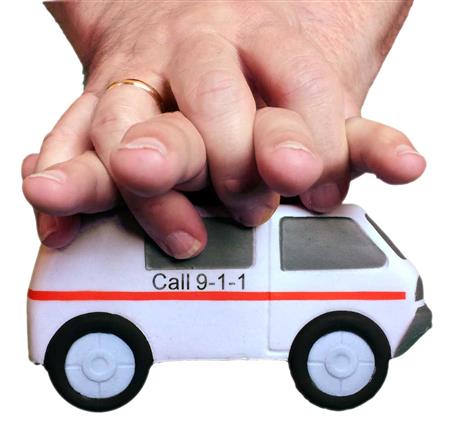Join in our District CPR Initiative! Why does it matter? The average survival rate from sudden cardiac arrest in our country is around 10%. This isn't because we have bad first responders. It's because on average from the beginning of the incident to the arrival their arrival, it takes first responders 8 minutes and 19 seconds to be on site to help. The problem is that when they arrive only 35 % of the time are the bystanders doing anything but watching the person die.
Leverage the Power of One to learn how to save a life!
If we did as communities such as Boston and Seattle that have done community-wide training initiatives that have raised their survival rates to 50%, we would save 450 lives every year in our area. Citizen CPR only takes 20 minutes to learn. That's 20 minutes to save a life...and the training is free.

Why learn CPR?
People think that it takes 3-4 hours and has to be refreshed every two years...and that's true if you learning CPR as someone required to know fully certified CPR. However, most of us just need to know what to do and that doesn't take full, certified CPR training. Citizen CPR only takes 20 minutes to learn and is compression-only (no assisted breathing). It's designed for "the rest of us."
Our afternoon service project at the 2017 District Conference Saturday centered around Citizen CPR. The average survival rate for sudden cardiac arrest in our country is between 7-10%. This is not because we have bad first responders…it’s because on average it takes them 8 minutes and 19 seconds to arrive after the start of a cardiac incident.
The problem is that when they do arrive, on average bystanders are only taking action to save the person’s life 35-40% of the time. Cities like Boston and Seattle have raised their survival rates from 10% to 50% by making sure more of their citizens are trained, starting in elementary school.
If we raised our survival rate in the same fashion, we would save 450 lives every year in just the Omaha, Council Bluffs, and Lincoln metros alone.
Aside from saving lives, why does this training matter? We think and worry about disasters like tornadoes....but living in Nebraska someone who lives 80 years has a 1-in-3.3 million chance of being injured by a tornado. That same person has a less than 1-in-1,100 chance of experiencing sudden cardiac arrest. In the U.S. alone, approximately 350,000 people of all ages experience EMS-assessed out-of-hospital non-traumatic sudden cardiac arrest each year and nine out of 10 victims die. In fact, the number of people who die each year from SCA is roughly equivalent to the number who die from Alzheimer's disease, assault with firearms, breast cancer, cervical cancer, colorectal cancer, diabetes, HIV, house fires, motor vehicle accidents, prostate cancer and suicides combined.
Why should encourage people to learn CPR? The life you save may be your own. You can watch the story of Lincoln South Rotarian Kay Wunderlich below. She experienced sudden cardiac arrest and is alive today because someone saved her life by administering CPR.
What can you do?
We started the ball rolling at the District Conference by training 300 people and donating 1,000 compression training tools to the Red Cross to jump start their Citizen CPR outreach program. Now we need your help to really make the full impact. Here's what you can do:
- In your club and community, get people trained. Reach out to as many people as possible and help them get training. This is an inexpensive and powerful club activity. Citizen CPR only takes 20 minutes to learn, is compression-only (no assisted breathing), and is free from the Red Cross, provided they have a volunteer in your area. If not, they can help you get a person with the right skills in place. If you have a relationship with another provider such as the American Heart Association, leverage that instead. The important thing is to get people trained.
- Track how many people you, your club, and your community have gotten trained and report them to Gary Bren (gbren@brenonline.com). Our goal is to powerfully demonstrate the Power of One by getting 5,000 people trained by the end of February, 2018. If we achieve that goal, it's very likely we'll save several lives in the next year.
To arrange training with the Red Cross, you can contact Sue Hensley with the Red Cross: Cell phone 402.917.5188 Emails: sue.hensley@redcross.org or shensley683@gmail.com.
